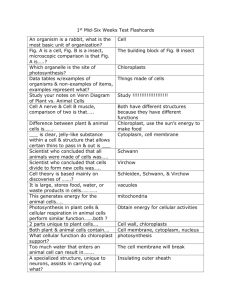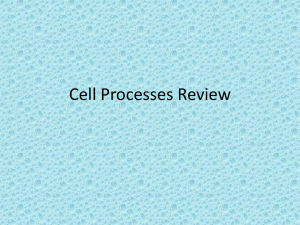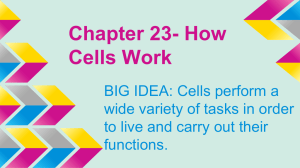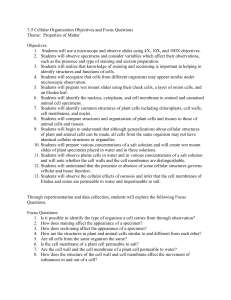Cell Transport, Cell Processes, and Specialized Cells Review 2014
advertisement
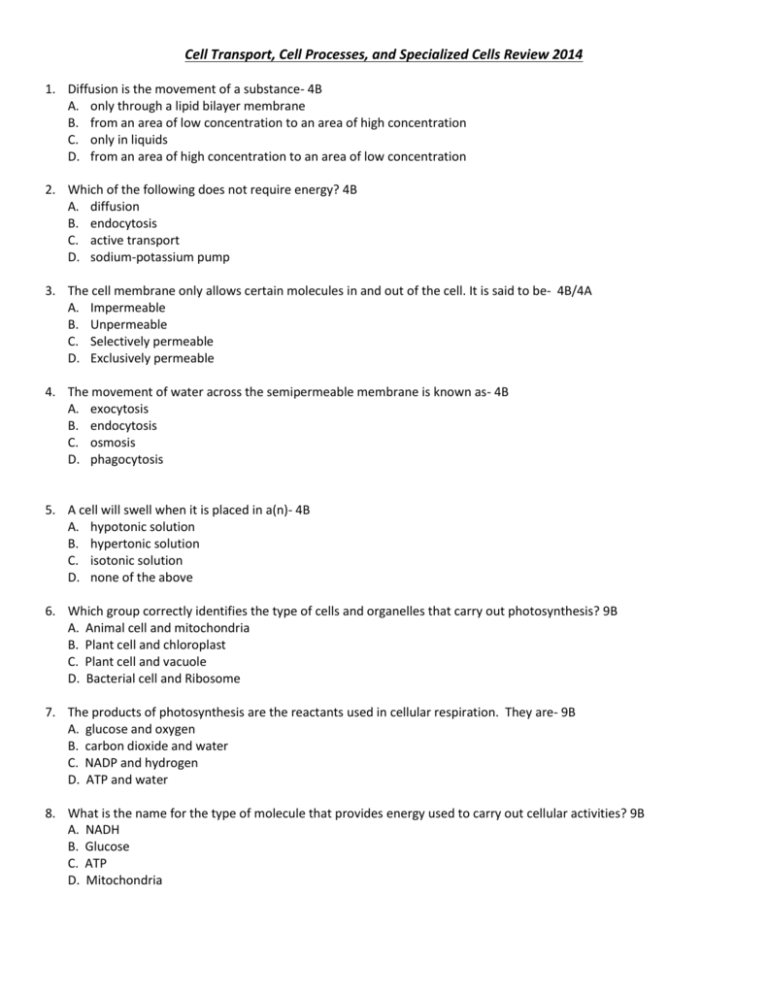
Cell Transport, Cell Processes, and Specialized Cells Review 2014 1. Diffusion is the movement of a substance- 4B A. only through a lipid bilayer membrane B. from an area of low concentration to an area of high concentration C. only in liquids D. from an area of high concentration to an area of low concentration 2. Which of the following does not require energy? 4B A. diffusion B. endocytosis C. active transport D. sodium-potassium pump 3. The cell membrane only allows certain molecules in and out of the cell. It is said to be- 4B/4A A. Impermeable B. Unpermeable C. Selectively permeable D. Exclusively permeable 4. The movement of water across the semipermeable membrane is known as- 4B A. exocytosis B. endocytosis C. osmosis D. phagocytosis 5. A cell will swell when it is placed in a(n)- 4B A. hypotonic solution B. hypertonic solution C. isotonic solution D. none of the above 6. Which group correctly identifies the type of cells and organelles that carry out photosynthesis? 9B A. Animal cell and mitochondria B. Plant cell and chloroplast C. Plant cell and vacuole D. Bacterial cell and Ribosome 7. The products of photosynthesis are the reactants used in cellular respiration. They are- 9B A. glucose and oxygen B. carbon dioxide and water C. NADP and hydrogen D. ATP and water 8. What is the name for the type of molecule that provides energy used to carry out cellular activities? 9B A. NADH B. Glucose C. ATP D. Mitochondria PHOTOSYNTHESIS GLUCOSE & OXYGEN X CELLULAR RESPIRATION 9. The diagram above gives an overview of the processes behind energy production. What goes in box X? 9B A. Water & Sugar B. Water and Oxygen C. Carbon Dioxide and Water D. Carbon Dioxide and Oxygen 10. Which group correctly identifies the type of cells and organelles that carry out cellular respiration? 9B A. Animal cell and mitochondria B. Plant cell and chloroplast C. Plant cell and vacuole D. Bacterial cell and Ribosome 11. What would happen to the body cells of a person who receives an injection of pure water solution? 4B A. The affected cells would shrink a large amount. B. The affected cells would shrink slightly. C. The affected cells would swell slightly. D. The affected cells would remain unchanged. 12. a. b. c. d. Energy conversion within a plant cell would be most severely limited by removal of the cell's 9B Golgi Apparatus Chloroplasts Ribosomes Endoplasmic reticulum 13. A few drops of Lugol's iodine solution placed in a beaker of water will turn the water red. A white starch solution was poured into a length of dialysis tubing and the ends were tied. The tubing was then dropped into the beaker of iodine solution. After 10 minutes, the white starch solution turned black and the iodine water remained red. What cellular structure was the dialysis tubing most likely representing in this experiment? 4B a. cell wall b. cell membrane c. vacuole d. nucleus 14. Diffusion and osmosis are both vital to cell function. Diffusion and osmosis are similar in that they are both types of – 4B a. protein synthesis processes b. passive transport processes c. cellular replication processes d. cellular metabolism processes 15. Which cellular process takes place in the ribosomes that are bound to the endoplasmic reticulum? 4B a. The breakdown of waste material b. The conversion of radiant energy to glucose c. The synthesis of new proteins d. The replication of nucleic acids The concept map below shows the flow of energy and materials in photosynthesis and cellular respiration. 16. Which molecules are represented in the figure by the number 1? 9B a. H2O and O2 b. H2O and CO2 c. Sugars and O2 d. Sugars and CO2 17. Parenchyma are cells that form a tissue in the middle of leaves. These leaf cells of the plant contain a special type of photosynthetic organelle called 5B A. xylem C. chloroplast B. phloem D. stomata The diagram below shows a cross section of a leaf. 18. Which of the following is the function of the guard cells on the lower surface of the leaf? 5B A. Synthesizing proteins B. Transporting water and minerals C. Opening and closing stomata D. Allowing light to enter the leaf 19. Vascular plants transport nutrients through specialized structures called xylem and phloem. What is the purpose of the xylem? 5B A. They take nutrients from the soil. B. They move water from the root through the plant. C. They capture the sun’s energy to make sugar. D. They move sugars and other nutrients from the leaves to the roots. 20. If an athlete could undergo genetic enhancement to increase energy for athletic competitions by doubling a specific cell organelle, which organelle would be the BEST one to increase? 5B A. Golgi apparatus C. nucleus B. mitochondria D. ribosome 21. Which of the following characteristics is not true of prokaryotes like streptococcus pneumoniae? 4A A. contain ribosomes B. contain DNA C. have cytoplasm D. have a nucleus 22. Select the tissue that covers all surfaces that come into contact with the external environment. 10C A. Nervous tissue C. Muscular tissue B. Epithelial tissue D. Connective tissue 23. Which cellular structure in plant cells is most responsible for rigid outer coating? 5B/4A A. Cell membrane B. Vacuole C. Chloroplast D. Cell Wall 24. Muscles cells have more mitochondria than other cells in the human body. The MAIN purpose of the extra mitochondria in the muscle tissue is so the muscle- 5B/4A A. B. C. D. can carry out extra activities that require more energy. can carry out waste not absorbed in the body. can carry responses quickly back to other cells. can carry water to other cells more efficiently. 25. Which of the following correctly describes the parts of an RNA nucleotide?- 9A a. Deoxyribose sugar, phosphate, nitrogen-containing base b. Ribose sugar, protein, phosphate, nitrogen-containing base c. Protein core, nitrogen base, ribose sugar d. Nitrogen containing base, phosphate, ribose sugar 26. The diagram to the right shows the structure of a unit that makes up proteins. These smaller subunits that make proteins are called-- 9A a. Amino Acids b. Lipids c. Nucleotides d. Monosaccharides 27. The diagram below shows a molecule made up of carbon, hydrogen, and oxygen. What is the name of the monomer that correctly identifies this structure? 9A a. b. c. d. amino acid monosaccharide nucleotide triglyceride
